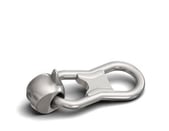How do I lift and move the blocks?
The following guidelines provide an overview on best practice when lifting Interbloc blocks. This should be read in conjunction with WorkSafe NZ Guidance on precast concrete.
Lifting Anchors
Interbloc blocks incorporate an Ancon® certified lifting anchor as the central lifting point. Standard Interbloc 1200 blocks use a 2.5t anchor 120mm long. 1800 and 600 blocks
Standard Interbloc 1200 blocks use a 2.5t anchor 120mm long. 1800 and 600 blocks
incorporate two 2.5t anchors, 120mm long. In all cases, the lifting anchors have a safety factor great than 5.
Foot anchors should be inspected and free of damage, nicks, or rust before lifting.
Lifting anchors are designed to be lifted vertically. Under no circumstances should the lifting anchor be used outside its design parameters.
Lifting Klaws

Ancon® lifting klaws are used to lift Interbloc blocks. The lifting klaw easily connects to the anchor head by inserting into the lifting clutch’s slot and rotating the tab of the clutch until it rests on the concrete
surface.
The klaws design means it cannot accidentally disengage while under load. Despite this, care should be taken when lifting.
Using any lifting device other than an Ancon® Klaw will void the block warranty and may lead to a failure of the lifting anchor. Lifting clutches should regularly be checked for wear and tear.
Lifting Machinery
Common equipment used when lifting blocks include:
• Forklift
• Excavator
• Front end loader (tractor, telehandler etc)
• Crane
Regardless of the machine chosen, it should have a minimum lifting capacity of 1 tonne for moving standard 1200 blocks, and 1.5 tonne when lifting 1800 blocks.
The use of any of the above lifting equipment is subject to relevant approved codes of practice issued by your local health and safety regulator. The operator of such equipment should be competent and aware of industry best practices and regulatory requirements.
Transporting loads over uneven terrain can induce anchor loads that are 5 times greater than those calculated from the weight of the concrete. As such, always lift the block using forks underneath when transporting over uneven terrain. Failure to do so will void the block warranty and may result in the lifting anchor failing.
Chains
Used to connect the lifting clutch to the lifting point on the lifting machine.
Only certified chains should be used to lift blocks.
Before lifting, chains should be inspected for:
• Current test tag
• Corrosion
• Worn, Stretched, or deformed links
• Worn, stretched, or deformed hooks and fittings
• Wear on load pins, ensuring retainers are installed correctly
Operators and installers should refer to relevant codes of practice issued by local health and safety regulators.
Excavator
When used to lift and manoeuvre the blocks, the chain should attach to the end of the excavator arm via a certified connection, preferably without the bucket.
Angle Of Chains
When lifting a standard 1200 block the chain hangs vertically from the attachment point on the machinery. When lifting either a 600 block or 1800 block, two chains are used to connect the lifting clutches to the machinery. The angle these chains hang from the machinery impacts the load capacity of the lifting anchors. At a minimum, both chains should be the same length.
When lifting either a 600 block or 1800 block, two chains are used to connect the lifting clutches to the machinery. The angle these chains hang from the machinery impacts the load capacity of the lifting anchors. At a minimum, both chains should be the same length.
As a minimum, the angle at which the chains hang from the machinery should be no greater than 60°.
Key Safety Rules
• Never stand under, or near a block while it is being lifted.
• Machinery should only be operated by competent persons with appropriate training and certificates.
• All lifting clutches, chains, and booms should be regularly checked and be in good working condition.
• Only Ancon® Klaw’s should be used, use of any other lifting clutch/device will void the block warranty and may result in failure of the lifting anchor.
• Blocks should never be transported over distances or rough terrain using the lifting anchor.
